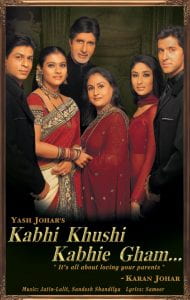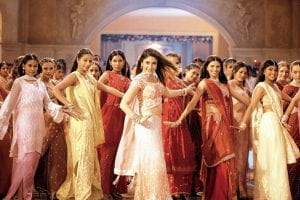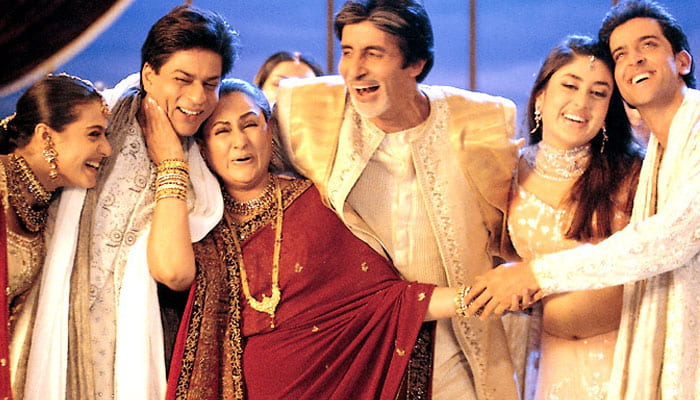We recently watched Kabhi Khushi Kabhie Gham for the class here at UMB on Indian Cinema with Professor Srinivas. While Bollywood is not entirely new to me, the deeper understanding of Bollywood within Indian culture is proving to be a delight and a great way in which to learn about Indian culture, as well as how traditional values are merging with more modern ideas. Below are my observations of some common themes to be found in this movie, in relation to class discussion. It may be unfamiliar unless you have seen it yourself, an experience I DO recommend! If you are interested in checking this movie out, it is available on Netflix. My discussion on the movie below talks of plot points, so could be considered to contain spoilers, as it speaks from a point of familiarity of the movie itself without an outline of the movie plot or characters beforehand. You have been warned!

Movie promotional poster
Watching Kabhi Khushi Kabhie Gham was not unlike how I usually become absorbed in binge watching a series. Normally I would not seek out such a long movie, but find such long tales more suited to a serialized experience, yet the structure of the movie made it fairly easy to set down after a time, and continue the next day. I found it to be absorbing and I was invested in the outcome of the story more than I expected to, a bit of a surprise because I do not consider myself to be a person who really goes in for romance as a major plot point. Throughout I did have to remind myself that I was watching this tale through the filter of Indian culture, as some aspects set off bells of disapproval from my feminist, Western viewpoint. I found it useful in these moments to think back to my own upbringing, which at times was a struggle between who I wanted to be and what my family, with a rather conservative Sicilian father straight from Sicily, expected me to be (in fact, I could draw some comparisons directly with some aspects of Indian culture, particularly in respect to concepts of family, and womanhood).
The music is an infectious masala of sound! Music at times borrowed from Western tradition as well as that of Indian culture, and the dancing had me tapping my toes and bouncing in my seat as I watched. I went looking for some of the songs to see if I could find lyrics translated, and like many cultures, love seemed to be a theme in many of them. Visual tropes were at times amusing – the constant gentle breeze ruffling hair, no matter what the setting may be, made me giggle frequently (it is so regularly portrayed!). The exotic locale of the pyramids in Egypt took me briefly out of the groove when it happened, as it seemed so sudden and unrelated, even as a fantasy sequence. I found myself wondering about the extreme wealth shown in the movie, in opposition to the everyday experience of most of India, particularly in seeing the Raichand mansion, which was also a bit of a jolt as it did NOT look to me to be a fit for India – understandable as we learned in class that indeed, the location was in England. Even the interiors are lavishly large, though at odds with the perceived architecture shown from the aerial shots, outside. The use of Western clothes (particularly skimpy ones) on Pooja (Kareena Kapoor), seems to be a contrast to those more “respectable” characters that wear saris as a sign of their maturity or even to signal and desirability as a wife.
“It’s all about loving your family” was a marketing byline used, and it very much captures the theme of the movie throughout. The loyalty and bond of the family unit is emphasized to an extended degree, emphasizing those bonds both within the bloodline of the family, and in those who are chosen to be family, shown through Rahul’s (Shah Rukh Khan) adoption and status within the family as the eldest. Extended and large family groups merge with large circles of friends. Those friends seem to sometimes escape the expected bounds of social status as the Raichand family is well acquainted, and apparent friends with, many people who are of lower status….except, it seems, when it come to arranging a marriage, in which case such social difference makes a large difference to the family, by judgement of the patriarch, Yash (Amitabh Bachchan).
Which brings me to the topic of romance and marriage within this movie. The film shows us the family-approved friendship/hoped for romance between Rahul and Naina (Rani Mukerji). It is only once Rahul becomes enamored of Anjali (Kajol) that the true conflict of the film occurs. In falling in love with a girl outside of the expected social class, and choosing to disobey his father the patriarch, he is disowned. Anjali’s character was goofy, not graceful and yet, grateful, kind and a prime example of the expected respect for elders, family, and the roles within Indian culture she is expected to fulfill. She is shown to be filled with love for her home of India, even more so when she is “exiled” in England – she continues the traditions of dress, instills in her child a respect and love for India and its culture, and yearns for the socially desired outcome of acceptance and blessing from Rahul’s family, in particular, from Rahul’s father. Lack of that blessing distresses her greatly, and there is a tone that indicates she feels shame that she was not accepted and will not stop at trying to achieve the honor of seeking that acceptance, a cultural expectation. That she is a good person, mother and wife is not enough – she feels that Yash’s lack of acceptance of her left HER at fault in the divide of the family, and in the disinheritance of Rahul.

What is a Bollywood film without DANCE?
Then, there is the patriarch himself, Yash. I was not surprised that no one in the class liked him – his stance was cold and even cruel when he rejected Rahul and Anjali. He seemed controlling and only concerned with this perceived disobedience, disregarding a family history of closeness and love as was portrayed many times through flashbacks, disregarding the distress his choice caused to his wife Nandini (Jaya Bachchan) and trying to gloss over it by chastising her and making note of her increasingly distant and colder treatment of him, her husband. He is a paragon of the family, and shown in what I perceived as a cultural expectation as a ruler of that family. The additional portrayal of “pati parmeshwar” in which a wife is expected to consider her husband a god, to pray and fast for him as one would other Hindu deities, fits with his expectation, which I, as a Westerner, find very uncomfortable and distasteful, as well as egocentric. Yet, I grew up with a family in which this was not such a far reach – you did NOT question the father in my family, as he was the absolute leader to not be questioned and to be obeyed as his judgement was thought to be the best choices for all in the family. Had our religion extended to multiple gods, I could see this easily being a part of that system of respect and familial hierarchy. In that light, I was delighted when Nandini finally stood up to Yash, and spoke her mind as she found herself disillusioned to that tradition; Yash was not a god at all, as he clearly was wrong. How dare he cause such pain and division, over a matter of will? Her pouring out her feelings to him in earnest was a high point of the film for me, in all honesty. Her making it known that she saw what he did as wrong and that he had lost her respect was a deconstruction of the patriarchal tradition that hit home for him, finally. He, the god, was wrong. And to his credit, he realized that this unchallenged power to rule over his family was a weakness that would leave him alone in that power, should he not relent. In doing so, it was good to see him realize that he missed his son. I think he also realized that unquestioned tradition was doing him harm, and harm to those he loved. Especially when he met his grandchild, and finally treated Anjali with respect, and gave the blessing that she and Rahul dearly desired from him. The honor they continued to give to him even at a distance in England showed how deeply the loss was felt to them, as a family, deprived of the completeness of the traditional Indian family unit as an identity marker.
The romance between Rohan and Pooja was a more modern take, and I did find myself wondering if the fact that Rohan (Hrithik Roshan) was not the eldest left him with less cultural pressure before the reconciliation between Yash and Rahul took place.
The movie was certainly engaging in ways I am not usually drawn to in Western equivalents. I could easily see the experience of anticipating and participating in this as a small cultural celebration being a delight to people in daily life, one that is communally shared and experienced enthusiastically. Since much of Indian cinema is family friendly, I find myself wondering if a happy ending like this is always part of such movies, as I could not expect for even one moment that they would not be reunited…yet I responded at the edge of my seat at times, calling out to my screen at the characters to get over their differences already! This is one of the few moments in my adjustment to remote learning that I have truly felt a moment of a “lesser than” experience, as I imagine as a class watching this together would have stirred some of that very communal response to it. During covid, I have daydreamed about travel again…now I will add to my travel goals that I may one day experience an Indian movie event in person, with people who are wholeheartedly fanatical about it.

The Raichand family share a moment of joy and unity

I love this film so much not tired of watching it.